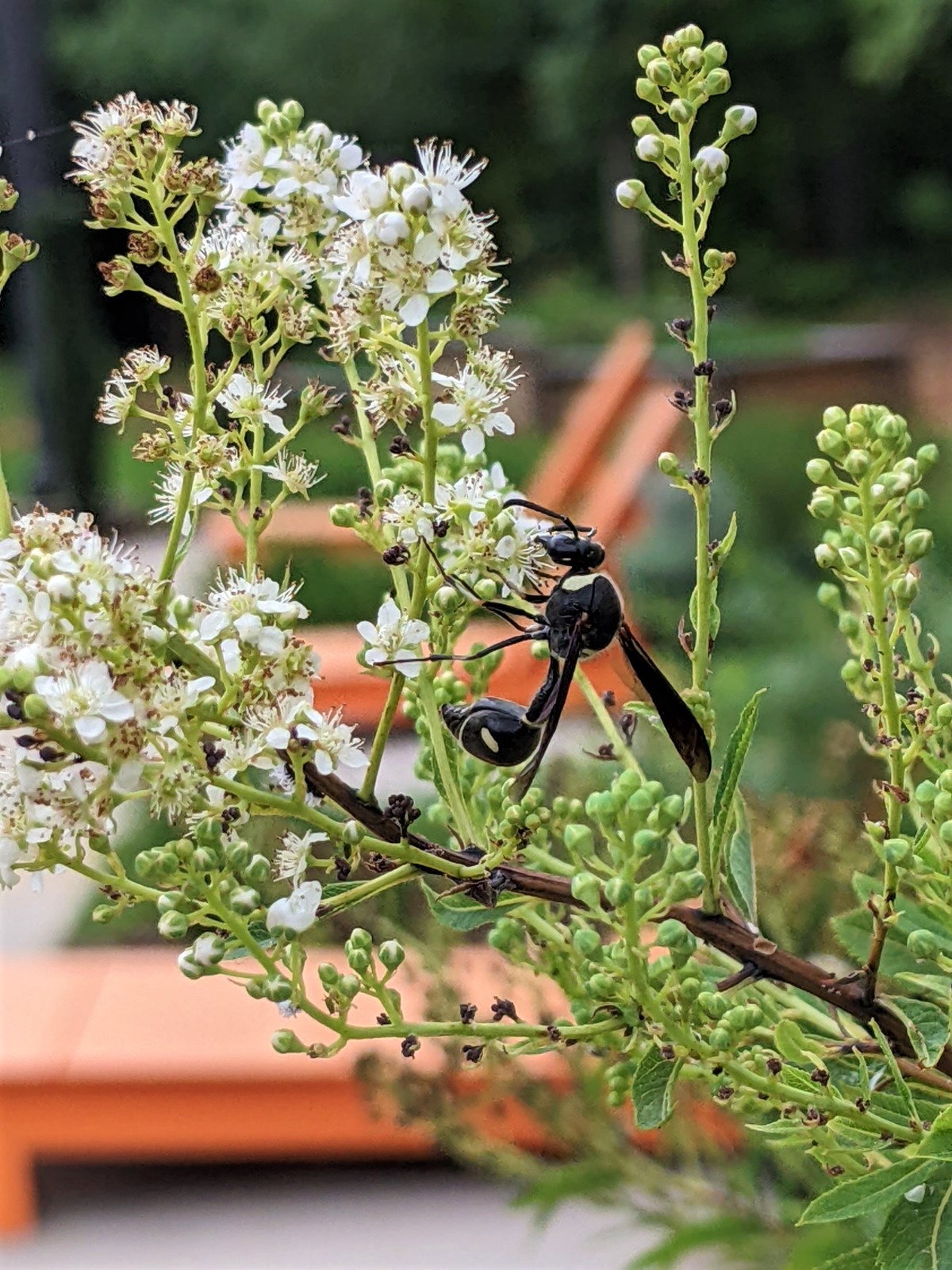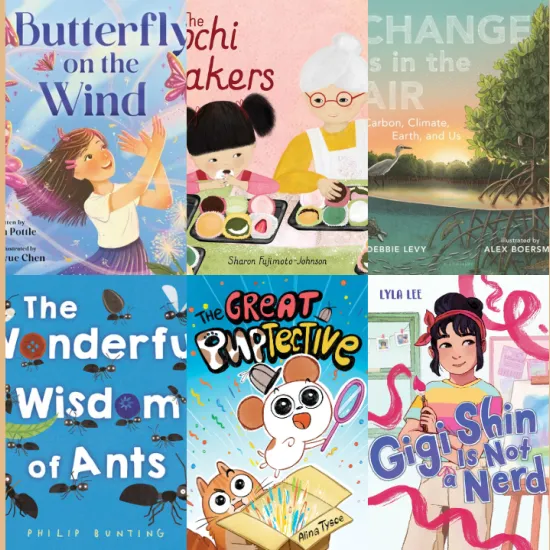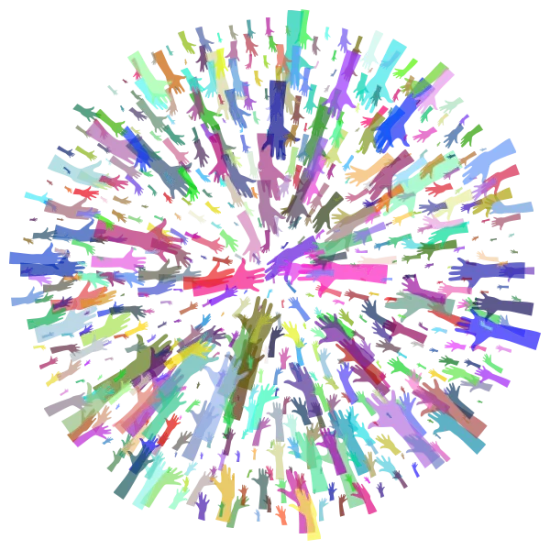- Melissa Sprenne
- Tuesday, April 18, 2023
Come by Richland Library Ballentine to see our Pollinator Gardens! Located right in the middle of our parking lot, you can see examples of native plants for yourself. We've included Stoke's Aster, Mountain Mint, Slender Leaf Mountain Mint, Blue False Indigo, Coral Honeysuckle, Dwarf Blueberry, St John's Wort, and more.
Pollinator gardening is gardening specifically with the needs of native insects, birds, and other wildlife in mind. These creatures and plants are vital to the well-being of our local ecosystems. Gardening with this intention doesn't mean giving up on having a beautiful garden! Native plants are just as colorful and pretty as anything you can buy in a big box store - and have the added benefit of being a useful and integral part of our environment.

Meadowsweet (Spiraea alba) with a Fraternal Potter Wasp (Eumenes fraternus)
Yes, wasps are pollinators, too! These are the ones that make the hollow mud tubes on the sides of buildings. They generally, like most things, won't bother you unless you are bothering them.
Why is pollinator gardening important?
So many species of plant and animal are in decline worldwide. Thousands upon thousands have gone extinct. We hear that all the time and rarely take the time to think about what that really means. Everything is connected and each species that goes extinct puts entire ecosystems at risk.
This is a simplistic example, but... pollution, over harvesting, and rising temperatures cause mollusks (one of the creatures that filters water) to go extinct in rivers and the water becomes too dirty for fish to live in and now we have no more fish fries on a Friday evening.
Our ecosystems are becoming less resistant and less robust, for many reasons: the fragmentation of our ecosystems, massive monocultures of farms and lawns, herbicides and pesticides, the importation of exotic species that become invasive, and more. It is all quite depressing. And overwhelming.
So why is what YOU do important?
Every time you plant with natives or create habitat of any size, you provide food and shelter for dozens of creatures!
Without your care and work, we’ll lose out on seeing fireflies, birds, butterflies, and many other fascinating critters.
Anyone can make their home welcoming! Even the smallest of spaces can be an oasis. From one container on a balcony to several on a patio, a driveway border to a half-acre garden to a full meadow, everyone doing what they can forms corridors for butterflies and other pollinators to travel and expand their range.
E V E R Y L I T T L E B I T H E L P S .
All right! How, specifically, do you create that pollinator friendly space?
Remember! You don't have to do all of these things at once. Start small, with one or two changes a year. And HAVE FUN! It's always a surprise to see what new animals will call your yard home even with small efforts.
- Be intentional in what plants you choose to plant. Use library resources: here's a booklist to get you started and a blog about how to create a Butterfly Garden using herbs you can find in any garden center. There are also native plant databases that you can search for your specific area: National Wildlife Federation's Native Plant Finder and Audubon's Native Plant Database. Best practices are to plant at least 70% native plants and 30% non-native ornamentals in a flower garden.
- Place rocks in sunny spots for basking - many insects and reptiles and amphibians enjoy a place to dry out or just absorb the warmth from the sun.
- Provide a source of water - birdbaths, shallow trays on the ground with rocks in so insects don't drown, ponds if you have room.
- Provide shelter - brush piles are perfect for birds and rabbits and all sorts of other interesting critters; leaving the dead stems of your plants in place over the winter provides overwintering places for native solitary bees and their young.
- Leave the leaves - many moth, butterfly, and firefly young live in the leaf litter. When you rake your yard and bag up the leaves to sit at the curb for pickup, you are literally throwing away so many insects. This is part of the reason why you don't see nearly as many fireflies as there used to be! If you must rake your yard, rake the leaves into mounds around trees and garden borders or use them as mulch.
- Reduce your lawn - the grasses that are used for lawns are useless, ecologically speaking. Their roots aren't deep enough to hold soil in place or trap water. They don't provide food or shelter. By all means, have some lawn where you or your kids can play outside. This also saves water and cuts down on the time you need to spend mowing!
- Don't use herbicides or pesticides - no matter what the companies that spray for mosquitos tell you, spraying to kill mosquitos absolutely kills other (beneficial) insects as well. Spraying herbicides to kill unwanted plants also harms nearby plants and the insects (bees) that feed on them. Besides, once your pollinator-friendly habitat is established, I think you'll find that you have far fewer pest insects! The birds, lizards, frogs, and other predatory insects that will now call your yard home will take care of many of those unwanted bugs.
Other useful resources
- Lady Bird Johnson Wildflower Center - for finding more information about native plants
- Butterflies and Moths of North American - for discovering which ones are native to your area, down to county (Fun Fact: there are 170 species of butterfly and moth that have been reported in Richland County but only 94 in Lexington County - I don't know why this is exactly, but I suspect that the big swamp at Congaree National Park in Richland County probably contributes to that higher number)


